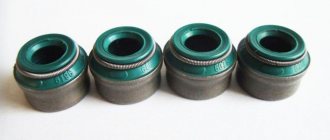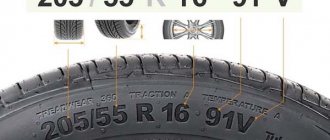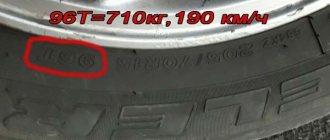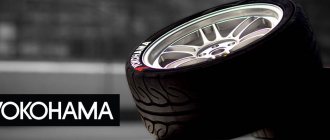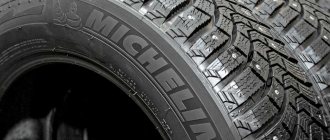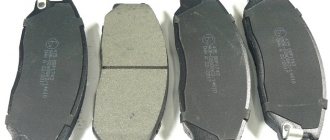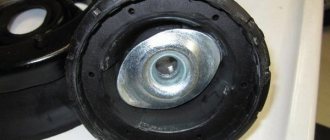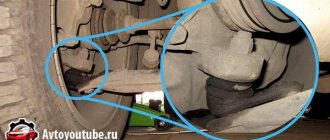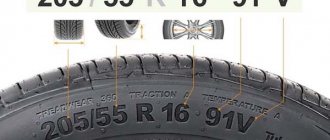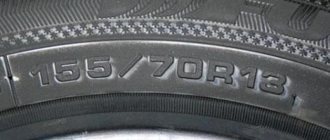A car tire must always be in good condition. Before the trip, the condition of the tires is checked. It is worth looking at the tread pattern. During regular examination, his condition is assessed. A tire tread wear indicator will help you check the depth of the grooves. They are different, it is worth considering this element of the tire in more detail.
What are the dangers of tire wear?
Many drivers pay attention to the condition of their tires only in winter. Slippery roads cause frequent accidents, so motorists change their car in time. In the summer, when the road is dry, many people believe that using worn tires will not bring any danger. They are very wrong. Using old tires is dangerous at any time of the year and in any weather. Let's look at some of the implications of this:
- The car becomes uncontrollable.
- The braking distance of the car increases, and this can lead to a traffic accident.
- Hydroplaning occurs - as a result of the appearance of a water layer between the road surface and the car, traction with the road is completely or partially lost.
- The car may turn around unexpectedly, then an accident cannot be avoided.
- If tires wear unevenly and pressure increases, a rubber explosion may occur.
Driving on bald tires is prohibited at any time of the year. In case of violation, drivers face a fine of 500 rubles or a warning.
The dangers of driving on worn-out car tires
The condition of car tires primarily affects the suspension. In fact, the wear pattern of tires is an indicator of the condition of the car as a whole. Uneven and increased tread wear is the consequence of various malfunctions that require elimination.
Car tires with even half-worn tread can become very dangerous companions when driving at high speeds. The grip of a car with the road surface in rainy and snowy weather deteriorates several times, which can cause road accidents.
Tests conducted using worn tires showed that the quality and reliability of their grip on the surface is two times worse compared to new tires.
Sipes located on winter tires help the car “bite into” the snow, providing excellent traction even on icy roads. In the case of a worn tread, small inclined sipes do not cope with their duties: the quality of the grip deteriorates, as does the traction of the car as a whole.
When driving on wet roads, the risk of hydroplaning increases: the faster the car moves, the higher the likelihood of this, since water does not have time to completely drain out through the tread grooves. A practically worn out tread significantly worsens the situation, since a large amount of water remains under the tire. The high risk of aquaplaning can lead to dire consequences, including an accident.
Hydroplaning a car on a wet road is very dangerous!
Rainy weather increases braking distances, which can be much more dangerous than hydroplaning. Compared to new tires, worn ones require up to 2 meters or more to come to a complete stop at low speeds - about 64 km/h - taking into account the use of an anti-lock braking system.
Worn tires perform best on completely dry tracks: almost completely worn out grooves and sipes have better contact with the road surface.
Despite the last advantage of worn tires, driving on them is extremely dangerous and undesirable: an increase in braking distance, an increase in the risk of aquaplaning and a decrease in adhesion to the road surface can cause traffic accidents.
How to tell if a tire is worn out or not
Most evaluation methods are available to the average user, although not all of them.
Tire appearance
A lot can be appreciated visually. For example, the color of rubber loses its saturation over time, and tires become characteristically whitish. This is a good sign that aging has occurred due to oxidation of the tire material.
Mechanical damage is also visible, both natural in the form of age-related cracks and delamination, and artificial, traces of numerous repairs, exposure of the cord due to cuts, convexity of the profile under pressure (bumps).
Uneven tread wear in the form of saw-tooth or bald spots is clearly visible. Such a wheel is dangerous when braking.
Profile depth measurement
To estimate the actual residual value, it is necessary to know the original tread size, as well as the minimum allowable for a particular tire model. A big mistake that sellers most often intentionally make is to calculate percentages based on absolute depth.
The tire cannot be used until it is completely worn out. Moreover, based on its intended purpose, rubber can completely lose its properties even with a sufficiently deep pattern.
This applies to winter, mud and all-season tires. They must effectively remove the soft component of the road surface from the contact zone, which is only possible with a sufficiently deep tread.
Digital indexes on the protectors
This is the most convenient way to determine wear, built into the tire design by the manufacturer. The tread rubber has indentations in the form of numbers, which disappear as the rubber wears off. The largest of the remaining ones determines the resource height of the relief.
Other indications are also possible; all types are simple and as intuitive as possible.
This is interesting: How and how to glue molding on a car door
To the extent that some manufacturers use color indication, when rubber of a different shade is embedded in the depth of the tread. A worn treadmill will then change its color to one that contrasts with the other surface.
Handy methods
Although it is almost impossible to find modern tires without wear indicators at all, the old methods continue to work. Between the blocks or tread tracks you can place a caliper depth gauge, which will show the remaining depth in millimeters.
All that remains is to subtract the minimum acceptable value from the resulting number. If you don't have a caliper, you can use a ruler, or even just a coin.
How to determine tire mileage
Wear indicator
It is a small column of rubber 1.6 mm high placed in the tread grooves. Actually, the tire requires replacement after the tread height is equal to this block.
Wear block located in the tread
You can determine where exactly the wear level indicator is located by looking for one of the marks on the side:
- triangle;
- TWI sign;
- brand logo.
Many manufacturers produce tires with intermediate indicators. Their scuffing indicates that the tires are no longer able to provide any proper grip on wet asphalt.
Digital indexes on the protectors
Digital indicators are extruded into the sipes and treads of the rubber, each of which differs in depth. The largest number (standard eight) is extruded to a shallow depth, the smallest (two for summer tires, four for winter studded or Velcro tires) to the maximum. As tires wear out, the numbers wear out and disappear. The remaining tread level is determined by the highest of the remaining numbers. Critical wheel wear is detected after the last indicator is erased.
Tire tread marking with digital wear indicator: example
Manufacturers apply three main types of digital indicators to protectors:
- A series of numbers from “2” to “4”, indicators are marked in millimeters;
- A series of numbers, indicators are marked as a percentage of the tread height;
- An indicator that has one segmented digit, made in such a way that each of its segments is extruded to a different depth. As the tire wears, different numbers appear. Such indicators are marked in millimeters.
Changing tire color
Relatively recently, wheels have appeared on sale that change color as they wear. When the rubber wears out, the tread turns a bright shade, which lets you know when the tires need to be changed.
Determining the level of tire wear by changing color is convenient, but the wheels do not always look aesthetically pleasing
Profile depth measurement
Indicators allow you to quickly determine the level of wear, but do not provide accurate results. To get accurate readings, use a profile depth meter - a small device that measures the depth of the tread grooves in several places. If the results obtained are less than those established by law, the rubber should no longer be used.
Determining tread wear using a tread depth gauge
Manual methods: coin, ruler, caliper
Perhaps the simplest and easiest way to measure the depth of the tread grooves is using a ruler or caliper. To do this, the caliper probe is lowered to the bottom of the groove and the resulting value is recorded. Tire wear is measured in the same way using a ruler - it is inserted into the tread and its depth is checked.
You can determine the level of tire wear with any metal coin - dollar, euro or ruble. For example, the dollar is lowered by the president's head into the tread groove. It's time to change the tire if Washington's hair is visible from the perpendicular line of sight. In a similar way, tire wear can be determined with a one-cent coin - only in this case the top of Lincoln's head should be visible.
Determining the level of tread wear using a coin - an express method
Russian double-headed eagle coins are also suitable for this method. Two rubles are placed in the groove with the eagle's head down. If the tires are in good condition and do not require replacement, then the bird’s head should not be visible, but tires need to be changed if the entire eagle is visible.
You can find out the condition of the tires using a one euro coin. If the gold rim disappears into the tread groove, then there is no need to change the tires, but if most of it is visible, then you will have to buy a replacement.
Why is it important to know your tire wear?
The main characteristics of car tires are provided by a convex pattern applied to their surface - the tread. Thanks to the tread, a contact patch between the tire and the road tread is formed, the wheel’s engagement with the road is ensured, and most importantly, the tread removes water, dirt and slush from under the wheel, ensuring better contact with the road surface.
However, rubber is constantly subject to wear, so over time the tread wears out and its height decreases. This entails a number of negative consequences, including a decrease in the speed at which “aquaplaning” begins, deterioration in controllability, an increase in the likelihood of skidding, etc., and wear on the tread of trucks and tractors also reduces the cross-country ability of these vehicles. Ultimately, excessive tire wear reduces vehicle safety and can cause an accident.
Therefore, tread height is strictly regulated by law, and every driver must comply with the established tire wear requirements. The remaining tread height, upon reaching which the tires can no longer be used, is established by paragraph 5 of the “List of faults and conditions under which the operation of vehicles is prohibited,” which is an appendix to the traffic regulations.
- Tire CORDIANT Business CA
4 250 ₽
- Tire Forward Professional 156 AShK tubeless
2 990 ₽
- Tire VIATTI Brina Nordico V-522 stud.
2 650 ₽
- Tire LTA-401 Rosava
6 890 ₽
- NOKIAN Nordman 5 stud tire.
3 120 ₽
- U-2 Nizhnekamsk 10-ply tire with tube
7 450 ₽
- Tire SATOYA SU-022 with tube and ob. tape
8 790 ₽
When to legally install winter tires in 2022
Good afternoon, dear reader.
Every year, as cold weather approaches, drivers begin to wonder when to put on winter tires. Currently, the answer to this question is partially regulated by a regulatory legal document.
The relevant law is Technical Regulations of the Customs Union TR CU 018/2011 On the safety of wheeled vehicles.
In this article we will talk about the legally established deadlines for changing summer tires to winter ones. In addition, a fine for improper use of tires will be considered.
- When can you use winter tires?
- Features of using all-season tires.
- Fines for improper use of tires.
Let's get started.
When is it legal to switch to winter tires?
Let's consider paragraph 5.5 of Appendix 8 to the technical regulations of the customs union TR CU 018/2011 “On the safety of wheeled vehicles”:
5.5. It is prohibited to operate vehicles equipped with tires with anti-skid studs in the summer (June, July, August).
It is prohibited to operate vehicles that are not equipped with winter tires that meet the requirements of paragraph 5.6.3 of this appendix during the winter period (December, January, February). Winter tires are installed on all wheels of the vehicle.
The terms of the operation ban may be changed upward by regional government bodies of the member states of the Customs Union.
So, what can be understood from this paragraph:
- During the summer months (June, July, August) only studded tires are prohibited.
- During the winter months (December, January, February), only winter tires are permitted. You can put both studded and non-studded tires on your car. The main thing is that they are marked “M+S”, “M&S” or “MS” and the corresponding drawing (in the picture on the left).
- The period of prohibition of operation can only be increased by local authorities and cannot be reduced. Those. In your region, for example, the use of studded tires may be prohibited from May to September. At the same time, regional authorities cannot reduce the period of the ban, i.e. From June to August, cars in all regions must not use studs.
Thus, there are the following intervals for using car tires:
- Summer tires (without M+S marking, etc.) can be used from March to November.
- Winter studded tires (marked M+S, etc.) can be used from September to May.
- Winter studless tires (marked M+S, etc.) can be used all year round.
Let's look at a table with periods of possible tire use throughout the year:
| Summer | Winter studded | Winter studless | |
| Winter (December – February) | + | + | |
| Spring (March – May) | + | + | + |
| Summer (June – August) | + | + | |
| Autumn (September – November) | + | + | + |
Thus, if you have summer tires (without markings) and winter studded tires, then you must replace them during the fall, i.e. from September to November.
The tire replacement should be done during the spring, i.e. from March to May.
Use of all-season tires in 2022
A separate group should include drivers who use so-called all-season tires (intended for use throughout the year).
All-season tires can be used during the winter months (December – February) only if they are marked “M+S”, “M&S” or “MS”.
Otherwise, the use of all-season tires in the winter months is not allowed.
Fine for improper use of tires in 2022
In 2022, Chapter 12 of the Code of Administrative Offenses does not contain references to the Technical Regulations of the Customs Union. Those. A fine cannot be imposed for not having winter tires. However, a draft of such a fine exists. You can find out more about it in this article.
However, there is a fine for using worn winter tires - 500 rubles (or a warning). This fine can be imposed on a driver using winter tires (marked M+S, etc.) whose tread depth at the most worn place is less than 4 mm. Please note that a fine is imposed only when operating a vehicle on an icy or snowy road surface.
Let's summarize this article:
- By law, you can change tires to winter ones from September to November.
- In practice, the choice of a specific date for replacement must be made taking into account weather conditions. However, I do not recommend changing tires later than November 15th - the unofficial day to change summer tires.
- There will be no penalty for using summer or all-season tires during the winter months in 2022.
Good luck on the roads!
pddmaster.ru
Traffic regulations
One of the key characteristics that is responsible for vehicle controllability and stability on the road is the tire tread height. Sometimes it is not possible to objectively assess this indicator by eye. In this case, a special indicator that is integrated into the rubber by the manufacturer will not help. It is the tread that provides high-quality traction between the wheel and the road surface, and it is especially important to monitor its degree of wear in bad weather. During and after rain, snow, and ice, the vehicle's contact with the road deteriorates significantly.
The traffic rules, for their part, regulate what the degree of wear should be, and clear quantitative indicators are provided for this:
- passenger cars - 1.6 mm;
- motorcycles - 0.8 mm;
- buses - 2 mm;
- trucks – 1 mm.
And in order to assess the tread height, we just need an indicator indicating tire wear. It is a part of the tread that differs in position, shape and size from the rest of the tire pattern. Most often, such an indicator is volumetric and placed in a groove. Another option is a digital beacon in the form of digital markings at different depths.
What labels do tire manufacturers use?
The Finnish company Nokian Tires, which introduced a digital indicator, came up with a snowflake-shaped beacon for winter tires. It can be either basic or intermediate. As the pictogram wears off, you can judge the wear of the tires and replace them in time.
Bridgestone has come up with its own indicator - these are arrows or stars on the side tread blocks. There may also be numbers in these places, for example, 4 mm. As a rule, 4 indicators are installed on one side of the wheel, at an equal distance from each other. As soon as the arrows or numbers begin to completely disappear, it means the tire has exhausted its service life.
Michelin also uses numbers, snowflakes and stars, both on the surface and deep into the tread. On the side profile you can find an indicator in the form of the Bibendum company logo (sugar or bandaged man), a triangle or the abbreviation TWI. The latter tells you where the indicator is located.
Main types of indicators
The simplest is a volumetric type determinant, which functions simply and clearly. As the tread wears off, it begins to compare with the height at which the beacon is located. This means that the tire must be replaced. Today, manufacturers equip tires with not only the main indicators, but also intermediate ones, so that the driver can monitor the wear of the pattern in advance and prepare for replacement.
We recommend: What you need to know about car alarms
The digital indicator on the tires looks somewhat different. Represents numbers extruded into the tire at a certain depth. The smallest number (usually 2) is at the greatest depth and vice versa. During operation, the tread will wear out, and the numbers themselves, accordingly, will disappear. As soon as the last one disappears, it means that the rubber has reached a critical level of wear. It is digital beacons that have become most widespread for the reason that they do not need to be deciphered, and even a child can understand their meaning.
How to determine winter tire wear Several methods to choose from
- letters TWI, which means “tread wear indicator”;
- manufacturer's logo;
- triangle;
- a square crossed out along the diagonals - this is what the intermediate indicator on the wheels looks like;
- numbers are control marks on Nokian or Matador tires;
- Bibendum - a very characteristic pattern that Michelin sprays.
- You need to measure at least 6 points around the entire circumference of the slope. If you buy used tires, it is better to double the number of measurements;
- The check is carried out not only in the center of the tire, but also along its edges;
- Why are lateral measurements needed? It's no secret that wear can be uneven. The degree of tenacity of the tire to the road surface is directly dependent on its type;
- If the tire has higher tread in the center than on the sides, it means the tire has been regularly inflated. In this case, your own tires must be replaced, but you should not buy commercial ones;
- The opposite situation indicates constant under-pumping. You can ride on such ramps, only wear is pretended to be minimal. If it is less than normal, go to the store for a new slope. See the article “What should be the tire pressure?”
AutoFlit.ru
Types of tire wear indicator
Despite the fact that the wear indicator of different brands of treads looks different, one thing remains the same:
- the indicator is made of the same rubber as the tire;
- The height of the indicator never falls below 1.6 mm.
In principle, for all tire brands, four types of wear indicators are most often found:
- in the form of a cord-shaped straight transverse “influx” relative to the tread grooves;
- in the form of volumetric numbers (usually the numbers are set from 2 to 8), standing out in relief against the background of the surface of the tread blocks;
- in the form of a symbol - for example, a drop of water (this designation is always adjacent to the digital designation of the tread thickness!);
- in the form of a change in the original tread color.
Where is the indicator located on the tire?
Most often, a tire wear level indicator (it may be absent on winter models!) is installed at the bottom of the tread groove: this is logically justified from the point of view of its gradual wear.
Visually, such a signaling device looks like a kind of “fused-on” column connecting two or three (sometimes four) tread “checkers” of different heights.
If you have difficulty finding the indicator, you can always clarify its location by examining the markings on the side of the tire.
If the tire wear indicator is made in the form of a change in their color, then, of course, there will be no grooves or raised numbers on the tread, since the tread itself consists of two multi-colored layers. During operation, the first layer of optimal driving thickness gradually wears off, and in its place a deeper layer of a different, contrasting color appears.
Where to look for indicators
Each manufacturer places indicator beacons in different places and depicts them differently. They can be in the form of numbers, protrusions, snowflakes, even colored inserts. This diversity is due to the manufacturer’s desire to distinguish its products from many competitors. As a rule, they are present on the inside of the defender channels.
Nokian products have two types of beacons: numbers are printed on summer tires, and snowflakes are printed on winter tires. These icons are divided into several levels. This makes it easier for the driver to assess the condition of his wheels.
For the Bridgestone brand, indicators look like arrows and stars on the side walls of the tread. Additionally, between the rows there are marks indicating the remaining working life in millimeters.
All well-known manufacturers have main beacons on winter tires in four places around the entire circumference. They are teeth or steps between the rows of the defender. To visually assess the condition of the tire using the indicator, you need to turn the steering wheel so that the tread looks out from under the arch.
Tire wear index
Each manufacturer indicates a so-called wear index on the tire profile, which most often looks like the inscription “Treadwear 100” and means a maximum of 48,000 km on a standard road surface (test site). In a real environment and often not the most ideal roads, this number actually needs to be divided by 1.5 - we get 36,000 km.
By analogy, if the wear resistance index is 150, then this means “factory” 72 thousand km, 200 – 96 thousand km, and so on.
Why are worn tires dangerous on the road?
- adhesion to the road surface deteriorates, which leads to an increased likelihood of skidding, accidents, and aquaplaning in the event of rainy weather;
- cross-country ability in off-road conditions decreases;
- the risk of a tire puncture while driving increases.
It is also worth remembering that the issue of tire wear is regulated by traffic rules, and you can get a fine for using “bald” tires. Knowing what maximum tire wear is permissible, this can easily be avoided: 1.5-2 mm for summer ones, and 4-5 mm for winter ones (a more accurate figure is indicated by the manufacturer).
Tire rotation direction. Asymmetrical tires
Not all tires are the same. There are tires for which the direction of rotation of the wheel matters, and which side of the wheel faces outward and which side faces inward. Such tires are called directional , or with an asymmetric tread pattern .
The correct direction of wheel rotation is indicated by an arrow and the word Rotation.
There are also inscriptions like outside . Which means you need to install the tire with this side facing out.
How to determine the side of a tire
Such measures are due to the asymmetrical or directional tread pattern, which is designed for effective adhesion to the surface. If the pattern is directional, it means that it only provides the desired tire performance when rotated in the desired direction.
Uneven tire wear: how to determine, reasons, dangers
If measurements show different results in different parts of the tread, it is important to determine exactly how your tires are wearing in order to understand where and what the operating error is.
If the tread is more worn on the sides and less worn in the center, this means that the tire pressure is insufficient and the contact patch with the road is not correct. This leads not only to poor vehicle stability, but also to increased fuel consumption.
If the tread is worn down in the middle but the sides are fine, this means your tires are overinflated. Sometimes this is done deliberately in order to save fuel, but in this case the tires will still have to be changed ahead of schedule.
There is also the possibility of increased wear on the inner or outer side of the tread - this signals improper wheel camber. A visual table with wear options and its causes:
What causes tires to wear out faster?
But the shelf life of tires established by GOSTs and declared by manufacturers can only be relied upon in ideal conditions. Circumstances that bring the tire replacement closer include:
- Improper storage. This can be said if the tires are in an excessively dry, unventilated place in direct sunlight all season, surrounded by corrosive metals, oils, greases and acids. The position of the tires is also important: if they are on rims, the best way to store them is to hang them, and it is better to put tires without rims on the edge. Such conditions are difficult to create on a balcony or in a garage, so the ideal option would be the services of car repair shops with special storage facilities.
How to visually assess tire wear: additional parameters
- Cracks on the sides of tires may indicate frequent off-road driving, improper storage, poor-quality rubber or long service life, as well as incorrect tire pressure.
- Bulges or “hernias” on the sides of tires are caused by the side of the tire hitting hard obstacles. Tires with such damage are not recommended for use.
- Dents on the tread indicate insufficient shock absorption and unadjusted wheel alignment. Having discovered such damage, it is necessary to take the car to a service center and make sure that the suspension is in good condition.
- Individual wear spots on the tread indicate aggressive driving/braking, skidding with wheel locking, or prolonged parking of the vehicle in one position.
Tire herniation (bulging) and sidewall cracks
What does it look like? Cracks and bulges on the sidewall of the tires.
Reason: -This usually happens from hitting a pothole (hole) on the road, a curb, etc. blows. Typically, any tire is well protected from such impacts. But, if the tire has insufficient pressure or is overinflated, then as a result of such an impact there is a high probability and danger that the tire will be damaged. Large cracks on the sidewall of the tire that run along the wheel rim tell us that the tire has been operated for a long time with insufficient pressure. Small cracks on the side surface of the rubber already indicate external damage or the age of the rubber (due to age, the rubber composition begins to chemically decompose, as a result of which the tire begins to crack).
The tire herniation itself looks like a bulge on the surface of the rubber. Most often, such a protrusion (hernia) appears on the side wall of the tire. A rubber hernia is usually associated with internal damage (the rubber layer). This usually occurs due to the side of the wheel hitting a curb, pole, etc. solid objects. Most often, after such an impact, a hernia (protrusion) of the wheel does not immediately appear. That is, after the blow itself, you can see the hernia only after a week or even after a month.
If you notice cracks or a hernia on your wheel tire, then you need to buy new tires as soon as possible.
Remember that using rubber with a hernia is very dangerous.
How to calculate tire wear as a percentage
Most often, this is required for the sale and purchase of used tires, in order to orient the buyer to the degree of wear. Many sellers give this figure at random, but this method has nothing to do with a real assessment of the degree of wear of the tire. It is also important to understand that a conditional 50% wear for a summer tire is an acceptable value, while 50% wear on the tread of winter tires is a sign that the tire cannot be used. Therefore, it is important to know how to accurately determine the percentage of tire wear in order to avoid getting into an unpleasant situation.
Many people divide the actual tread height by the height of the same, but new tire, and get a certain percentage of wear. This would be correct, if not for one BUT: we cannot physically erase the tread to zero, and the law prohibits the use of tires with a tread below the permitted values.
You can calculate actual tire wear by dividing the difference between the height of the new tire and the actual height by the difference between the tread height of the new tire and the minimum possible tread height for that tire, and then multiplying that number by 100.
If you cannot find out the height of the same, but new tire, use the average values of your tire type:
We recommend: Semi-trailer repair
| Tire type | Average tread height at start of use |
| Winter tires with Scandinavian tread | 10 mm |
| Winter with regular or asymmetric tread | 9 mm |
| High-speed winter | 7 mm |
| Summer tires with classic tread | 8 mm |
| Summer expressways | 7 mm |
You can check summer tires for wear a little less often than winter ones, since in the summer the tread depth is not so important for cross-country ability.
If you have assessed the condition of your tires based on all of the above factors and realized that the tires are worn out, be sure to replace them with new ones as soon as possible.
Colored tire markings
You may have noticed that some new tires have colored markings, 2 colored dots, red and yellow. This was done for better wheel balancing during tire fitting.
Colored tire markings
The yellow dot indicates the lightest spot on the tire. When mounting tires, this mark is aligned with the hole in the rim for the nipple.
The red dot is the hardest part. Or a part with greater heterogeneity of the material.
Colored stripes on the tire tread
Colored stripes on the tread are mainly used to facilitate sorting in warehouses and for logistics purposes. They do not carry any other information.
Types of tread wear indicators
Manufacturers solve the problem of label placement in different ways. First of all, they are located in different places.
- At the bottom of the grooves. This is the most common option.
- On tread blocks. Color identification is used here. It is not considered the most reliable method.
- On the sides. Primarily focused on the wear of shoulder blocks, it is often used on off-road tires.
Knowing where the indicator is located, it is much easier to find it.
In addition to location, there are different types of indicators. This must be taken into account so that you do not have to look for a non-existent mark.
- Tubercle. Usually located deep in the groove. Has the minimum height allowed for a specific type of tire. For summer tires the height will be 1.6 mm. The level of wear is easy to determine; if the groove is level with the tubercle, the tire should be replaced.
- Colored marks. The principle of operation is simple - to show that the tread block has worn down to a minimum value. Sometimes such indicators are erasable, in which case the mark is made to a certain depth. As soon as it disappears, it is worth changing the tires. Another option is a recessed mark; in this case, the colored mark appears only when the rubber before it is worn off, which indicates the tire has failed.
- Digital tags. They work similarly to color ones, but they use numerical values that tell you how much tread depth is left. Valued by drivers who often travel long distances. Also, such marks allow you to determine the time of changing tires between axles.
The location of the mark can be found by the triangle on the sidewall. It shows where the indicator is located on the tread.
Normal
Evenly worn tread indicates that the tires were stored correctly. This also serves as an indicator of the correct setup of the car's chassis. In addition to wear, it is also important to pay attention to the presence of microcracks.
Central
It indicates that the car is running on overinflated wheels. Since the rubber has become harder due to increased pressure, the wheel only adheres to the road in the central part.
Bilateral
This type of wear is typical for driving on low tires. In this case, the contact patch moves to the edges. The stiffeners are under load, and the rough road surface does its job.
Unilateral
This type of wear is typical for cars in which the axle geometry is incorrectly configured. If the tires wear more strongly on the inside, this indicates negative camber. External wear is a sign of positive wheel camber.
Low-quality rims can also be a problem. With strong impacts (a hole with sharp edges, a curb, etc.), it may become deformed, but this may not be noticeable from the outside.
Spots
This wear most often indicates improper wheel balancing. If balancing does not help fix the problem, you need to take the car to a service station to diagnose the suspension. The levers or damper struts may be faulty.
Sawtooth
For driving on loose and very wet soil, special tires are created - “alligator” or “button”. They feature a block pattern with rounded sides. These tires may experience sawtooth wear. This happens due to frequent travel on roads with poor surfaces.
This problem also occurs when the wheel toe angle is incorrect.
In addition, watch a video overview of common types of wear and how to fix them:
Uneven tire wear: causes and how to fix it Watch this video on YouTube
Uneven on each tire of a pair on one axle
It happens that the left tire is worn out more than the right one (or vice versa). Most likely, this means that when purchasing new cylinders, the car owner did not look at their production date. Tires from different batches may wear differently. If this is not the reason, then you should check the wheel alignment.
Types of abnormal wear
The most common types of uneven wear are:
- Tire wear along the edges of the tread on both sides (along the entire circumference).
- Tread wear in the central part (around the circumference).
- One-sided edge wear.
- Abrasion of the sidewall or middle part of the working surface (in places).
- Hernia on the wheel.
- The appearance of a plane on the surface of the tire.
Tire wear on both edges
Let's go through each type. So, wear along the edges on both sides of the rubber (visually you can see that the tread on the sides is worn out much more than in the central part) indicates that the pressure in the wheels is below normal. This happens because the tire bends in the central part, and the main load falls on the side areas. It is worth noting that this result is caused by operating tires with insufficient pressure for a significant period.
Wear of the central part of the tread
But wear in the central part indicates excessive tire pressure. Under such conditions, the roundness of the working surface is higher, so only the middle part of the tread is in contact with the road, and the side parts simply do not touch it.
One-sided tire wear
One-sided wear, most often this is wear on the inside of the rubber - the result of incorrectly set camber/toe angles. If wear is noticed on the inside, then the corners are strongly tilted in the negative direction, and wear on the rubber on the outside means that the camber value is positive (for front-wheel drive cars, these angles should be 0).
The above listed rubber wear occurs around the entire circumference of the wheel. But it often happens that abrasions on a tire look like spots, and there may be several or just one. Typically, these types of wear occur in the middle part of the tread, although they also occur on the side areas.
Stained wear
If there are several such spots, and they are located in a circle, then this may indicate:
- wheel imbalance;
- violation of the geometry of the brake system elements (ovality of the drum or waviness of the disc). As a result, during intense braking in certain places, the wheel simply blocks, thereby exposing the same section of the tire to increased friction;
- excessive wear of the suspension, steering mechanism;
Tire wear due to emergency braking
But if only one spot is noticed, then this is the result of emergency braking, during which the wheels were completely blocked.
Hernia on the wheel
The appearance of “bumps” on the tire is the result of the use of low-quality cord in the design, strong impact loads, under which the cord threads simply break and the tire loses strength.
Tire deformation during long-term parking
The appearance of a platform (flat surface) on the tire circumference is the result of a car being parked for a long time without moving. Therefore, the section of the wheel that was in contact with the canvas took its shape
At the same time, if you do not pay attention to this and start using the car, then increased loads (beating) will occur at this site, which will lead to the appearance of an erased spot. But this type of wear is very easy to eliminate by inflating the wheels, after which the car needs to be moved and left for a while (air pressure will restore the surface)
All of the listed types of wear (except the last) affect traffic safety, so such tires already require replacement, although not urgently (does not apply to the appearance of hernias on the wheel). But they will still have to be replaced in the near future.
Why pay attention to wear and tear?
Every part of the machine wears out to one degree or another and eventually needs to be replaced. In the case of tires, their quality not only determines the safety of the passengers and driver in the vehicle, but also the safety of other road users.
Monitoring the condition of your tires is part of standard vehicle maintenance. An attentive motorist periodically checks the engine oil level, the amount of coolant, the serviceability of the brake system, and lighting fixtures.
The depth of the drawing is inextricably linked with the following factors:
- Vehicle controllability. The lower the height of the pattern, the worse the removal of dirt and water, and this increases the risk of losing control of the car when driving through puddles. When turning on dirt roads, the car may skid due to poor traction.
- Braking distances. A worn-out tread reduces tire adhesion even on dry asphalt, causing the braking distance to increase under the same operating conditions.
- Uneven wear of the lamellas may indicate some vehicle malfunction, for example, wheel imbalance or the need to adjust the wheel alignment.
Why is this so important?
The main characteristics of any tire are determined by the shape and height of its tread. It is the latter that affects the traction of the wheels (and, accordingly, the entire car) with the road. Also, the tread height affects the quality of dirt and water removal. Thus, thanks to the pattern and its thickness, the best contact with the road surface is ensured.
But car tires are subject to constant wear and tear. After some time (this is a mileage of more than 80 thousand kilometers), the tread thickness decreases several times. Why is it so important to look at your tire tread wear indicator? If the height of the pattern decreases, this entails the effect of aquaplaning. When hitting a wet surface, the contact of the tires with the road is lost and the driver loses control. As for winter tires, the problem is different. It is difficult to drive out of a snow drift on bald tires. The braking distance also increases noticeably. This may cause an accident.
Car tire service life
Most manufacturers set a maximum service life of ten years. However, this figure is relative. Here are the main factors influencing the suitability of car tires:
- How was the tire stored?
- Under what conditions was it operated?
- Natural aging.
The expiration date is the period established by the manufacturer during which the tire does not lose its properties. This period begins from the moment of manufacture, and not from the date of purchase. This information can be found on the side of the tire. It looks like four numbers. The first two indicate the week, and the rest indicate the year of manufacture.
For example, when buying “new” tires that have been stored in a warehouse for four years, you can use them for no more than six years (if the warranty period is limited to 10 years). Even if it was stored correctly, rubber tends to age, which is why microcracks appear on it and it loses its elasticity.
It is also worth considering that different types of tires are created for winter and summer operating conditions. There is also a third variety - all-season. Some motorists use it to save money.
For example, owners of front-wheel drive cars put tires on the rear wheels so as not to buy a full set of winter and summer tires. In fact, experienced drivers do not recommend conducting such “experiments”, since the “universal” version has a shorter service life and is not as reliable as a model for a specific season.
Summer tires
When making car tires, to increase their elasticity, manufacturers add rubber to its composition (in addition to additional substances that affect product quality). This polymer acquires different properties at different temperatures:
- at -70 degrees it begins to crystallize;
- at +180-200 degrees it becomes fluid;
- at +250 rubber breaks down into gaseous and liquid substances.
We recommend: Get income from your car
Since mainly in summer the temperature of the air and road surface exceeds +10 degrees, less rubber is added to tires than rubber.
Due to their increased rigidity, such tires are more resistant to wear than winter tires. The tread in it is not as deep (most often 7-8 millimeters) as in the winter version, since its main task is to remove water and dirt from under the wheel. For winter options, it is important that snow does not linger between the slats, so the pattern in them is deeper and wider.
In addition to these characteristics, you also need to focus on riding style preferences. For a measured mode, certain tire characteristics are required (pattern, stiffness, depth and width of the pattern), for sports driving with sharp maneuvers - others, and for offroad - still others.
Summer tires are not as noisy as winter tires. Over the entire period of operation, they experience less load due to temperature changes (in winter it is warm in the garage, but frosty outside), as well as due to a sharp change in the quality of the road surface (in winter, there may be snow on the road during one trip, ice, water).
Due to these characteristics, the service life of summer tires practically corresponds to those declared by the manufacturer.
Here is a short video test of summer tires:
Which tires will make your car look better? Summer tire test: 17 inches, 2018 season Watch this video on YouTube
Winter tires
The first difference between winter tires and summer tires is their elasticity due to the increased rubber content. Without this polymer, rubber at subzero temperatures not only loses its plasticity, but also the process of its glass transition begins. Because of this, normal load during a quiet trip can be fatal for summer tires if it is frosty outside.
Since in winter the car often drives on snowy sections of the road, winter tires need a deeper tread with wider sipes. Thanks to this, the pattern is not clogged with snow, and the tire “clings” not to a soft layer of snow and dirt, but to a harder surface. Such characteristics are very important not only when cornering, but also when driving uphill.
Here is a comparative table of how the efficiency of winter tires changes with different tread depths (185/60 R14 tires with different degrees of wear are taken as an example):
| Winter, 8 mm tread. | Winter, tread 7.5 mm. | Winter, 4 mm tread. | |
| Snow grip, % | 100 | 60 | 48 |
| Braking on snow, % | 100 | 97 | 86 |
| Hydroplaning, % | 100 | 95 | 73 |
| Braking on dry asphalt, % | 100 | 106 | 118 |
| Braking on wet asphalt, % | 100 | 103 | 93 |
Considering the elasticity of the material, the tread in this type of tire wears out faster than that of its summer counterparts. Although manufacturers often set the same service life for both summer and winter tires, the latter recommend changing when passing:
- passenger car (up to 2000 kg) 40-45,000 km;
- truck (2-4 tons) 60,000 km;
- truck (over 4,000 kg) 65-70 thousand.
Look also at the rating of winter tires (2019):
The most honest rating of studless winter tires for 2022! Watch this video on YouTube
Tread overview
The tire tread can have a different pattern to ensure the required performance characteristics. There are currently four variants of stingrays. They are designed for different road conditions and driving styles.
The symmetrical non-directional pattern remained the most popular for a long time. All applied recesses, slots and protruding parts have a mirror image relative to the center. The main advantage of such a ramp is its ease of installation: the wheel can be located on any side and rotate in any direction. The tire has the most balanced characteristics. It can provide comfort and smoothness. The production of symmetrical non-directional slopes costs less, so tires are cheaper at retail.
For the best water drainage for passenger cars, manufacturers began to produce tires with a symmetrical directional tread pattern. Such ramps are often used on dynamic and sports cars. It should be taken into account that the tire rotation must be carried out in a certain direction. It is indicated on the side of the wheel.
To give tires more characteristics, manufacturers use an asymmetrical non-directional pattern. Such slopes perform well both in rain and on dry asphalt. Sometimes all-season tires are produced with this tread pattern.
A tire with an asymmetric directional tread usually has the greatest number of qualities. Such stingrays cope well with the most difficult weather conditions. At the same time, their installation requires taking into account the direction of rotation, as well as compliance with the installation of the outer and inner parts of the wheel.
Each type of tread pattern has both advantages and disadvantages. A brief overview of the pros and cons is presented in the table below.
Table - Advantages and disadvantages of protectors.
Permissible tread wear for summer and winter tires
According to the law, the critical pattern depth for summer tires is 1.6 millimeters, and for winter tires – 4 millimeters.
In addition to this limitation, there are some amendments for different types of vehicles (summer tires):
| Vehicle type: | Wear limit value, mm. |
| Passenger and light duty trucks | 1,6 |
| Cargo | 1,0 |
| Bus | 2,0 |
| Motorbike | 0,8 |
For wide-profile summer tires, the established minimum value is 1.6 mm. too little, so experts recommend replacing it already with a remaining tread depth of 3.0 mm.
Don't wait for the tires to wear down to a minimum. This increases the risk of increased braking distances on wet roads and aquaplaning, since the tread no longer effectively removes water from the contact patch.
Remaining tread depth
The minimum depth of the pattern is regulated by the regulations for the admission of wheeled vehicles. All tolerances for tread size are described in detail there. Summer tires for passenger cars should not have a tread depth of less than 1.6 mm. For trucks this parameter should be at least 1 mm, for buses - 2 mm.
Winter tires must have a tread of at least 4 mm. This is a mandatory requirement for tires.
The wear indicator greatly simplifies monitoring the condition of tires. With the help of this tire element, you can promptly notice the need to install new tires. It is better for the driver to know all possible types of tags.
Effect of wear on handling
Over time, tire wear leads to a number of changes in the behavior of the car. What happens to worn-out slopes:
- Handling in severe weather conditions deteriorates;
- On wet, icy or snowy roads, braking distances increase;
- On dry roads, worn wheels brake better due to weight reduction;
- Fuel consumption is reduced, because the lower the tread, the lower the rolling resistance.
Undoubtedly, driving on more worn-out wheels has its advantages, but the disadvantages are more significant, because they can cost the motorist his entire car or even his life. Keep an eye on your vehicle so you don't become a victim of cost savings!
Tire tread wear, indicator on rubber was last modified: April 25th, 2022 by abc-tyre
Stickers on new tires
You've probably all noticed the colored stickers on new tires, but not all of you know what they mean. let's take a closer look.
Stickers on new tires
RRC (Rolling Resistance Coeficient) - Rolling resistance coefficient.
RRC - Rolling Resistance Coefficient
Indicated by a letter index from A to G. The best indicator is considered to be index A. The rest increase fuel consumption on the reference car in accordance with the table. a passenger car that consumes 6.6 liters. gasoline per 100 km.
Noise level outside the car
Noise level outside the car
It is measured in decibels (dB) and is indicated by a picture of a speaker and a wheel. Completely black waves mean a noise level of 75 dB or higher, which will be prohibited in EU countries from 2016. The remaining data is shown in the figure.
Grip on wet asphalt
Indicated by letters from A to G. A - the best performance, that is, the shortest braking distance on wet asphalt.
Grip on wet asphalt
WGI - wet grip index , measured in % relative to the reference width.
The table shows the differences in braking efficiency for different grip classes on wet asphalt.
Tips and tricks
Please note that there are several ways to increase the life of your winter tires. First of all, you must follow the rules for using tires. It is also important to constantly maintain the recommended tire pressure by checking the indicator with a tire pressure gauge. If the pressure is higher or lower than normal, tire wear will accelerate significantly.
We also recommend reading the article about what the Rotation sign on tires means. From this article you will learn about the features of the tread, types of tread patterns, direction of tire rotation, etc.
Tire wear is also greatly influenced by the condition of the car's chassis, or more precisely, the suspension. It is required to regularly check the wheel alignment, as well as eliminate any existing faults.
Finally, we note that rapid wear of tires, especially soft winter ones, occurs when wheel imbalance appears and a beating is felt on the steering wheel. In this case, the problem may be with the disk or tire itself (it is necessary to roll the disk and balance the tire).
Also, imbalance in winter often occurs as a result of the accumulation of snow and ice on the disc, which also leads to wear. To eliminate this factor, it is recommended to warm up the car in a warm parking lot or garage, remove snow and ice from the wheels at a car wash, etc.
As a summary, we note that winter tires are soft and are resistant to side cuts and heavy loads on the sidewall. This means that when cornering, it is better to slow down as much as possible and avoid getting into holes and potholes (especially with sharp edges). This approach allows you to avoid the premature appearance of hernias on the tire, cuts, ruptures and other defects.
Circumferential and spot wear
Imbalance is very often the reason why tire wear is extremely abnormal. Most often, it is the front axle that suffers from this problem. Simple balancing helps get rid of this defect. The main thing is to carry it out until the wheel loses its shape.
Important! If you have balanced and changed the tires, and abrasions still appear in the same places, then the problem is in the suspension. It usually lies in faulty levers or shock absorbers.
Using damaged tires not only affects driving safety, but also the technical condition of the car, which can lead to serious damage in the future. If we are talking about a single spot, then in most cases it is the result of emergency braking.
Sawtooth
This defect can very often be seen on block drive axle protectors. It occurs as a result of wheel deformation, the latter appears when tire blocks are crushed and dragged along the asphalt. The result is extremely predictable - the protective coating simply wears off.
Important! The only way to minimize sawtooth wear is to periodically swap the front and rear wheels.
conclusions
Although every driver should constantly monitor the height of the pattern, it is worth paying attention to the service life of the product (it is up to 10 years). Even if the tread has not worn off during this time, the rubber loses its properties. Its elasticity deteriorates, becomes brittle, cracks and oxidizes. In this case, replacement should be made after the service life has expired.
Timely maintenance of the car's chassis and suspension, appropriate pressure and proper seasonal storage will help extend the life of tires during active use of the car.
Sources
- https://rad-star.ru/pressroom/articles/kak-proverit-iznos-shin/
- https://AutoVogdenie.ru/kak-opredelit-iznos-shin-4-sposoba.html
- https://www.avtoall.ru/article/5503245/
- https://avto-kul.ru/ekspluatatsiya-avtomobilya/indikator-iznosa-shin.html
- https://bbshina-tyre.ru/press-tsentr/stati/103162/
- https://www.kolesa-darom.ru/articles/kak-opredelit-iznoshennost-letnikh-shin/
- https://tires1.ru/indikator-iznosa-protektora-shiny/
- https://AvtoTachki.com/kak-opredelit-iznos-shin/
- https://abc-tyre.ru/iznos/
- https://KrutiMotor.ru/srok-sluzhby-zimnej-shipovannoj-reziny/
Tire wear time
Each car tire has its own service life. For some tire models it is smaller - usually soft and comfortable, for some it is larger - usually intended for commercial vehicles with high annual mileage.
In general, most tires for passenger cars have a service life of approximately 50-60 thousand km. In terms of time, this is, as a rule, no more than 3-4 seasons (with an average annual mileage of 25-30 thousand km and an annual change of seasonal sets of tires).
It is also worth saying that in addition to mileage restrictions, each tire, like any other rubber product, has a limited service life. Almost all car tires are designed to last no more than 5-7 years, after which they lose their properties. The marking on the sidewall of each tire must indicate the year of its manufacture.
Thus, if the wear of the tires still allows you to drive on them for quite a long time, but the service life has already exceeded the permissible 7 years, this tire has already lost its original properties and has ceased to provide the necessary traffic safety. It is better to replace such a tire.
It should also be noted that when purchasing new tires in a store, be sure to check the year of manufacture in the markings on the sidewall. Tires can often sit in storage for two or three years before being sold. Thus, the car owner who buys such tires will certainly reduce their possible service life by 2 or 3 years.
